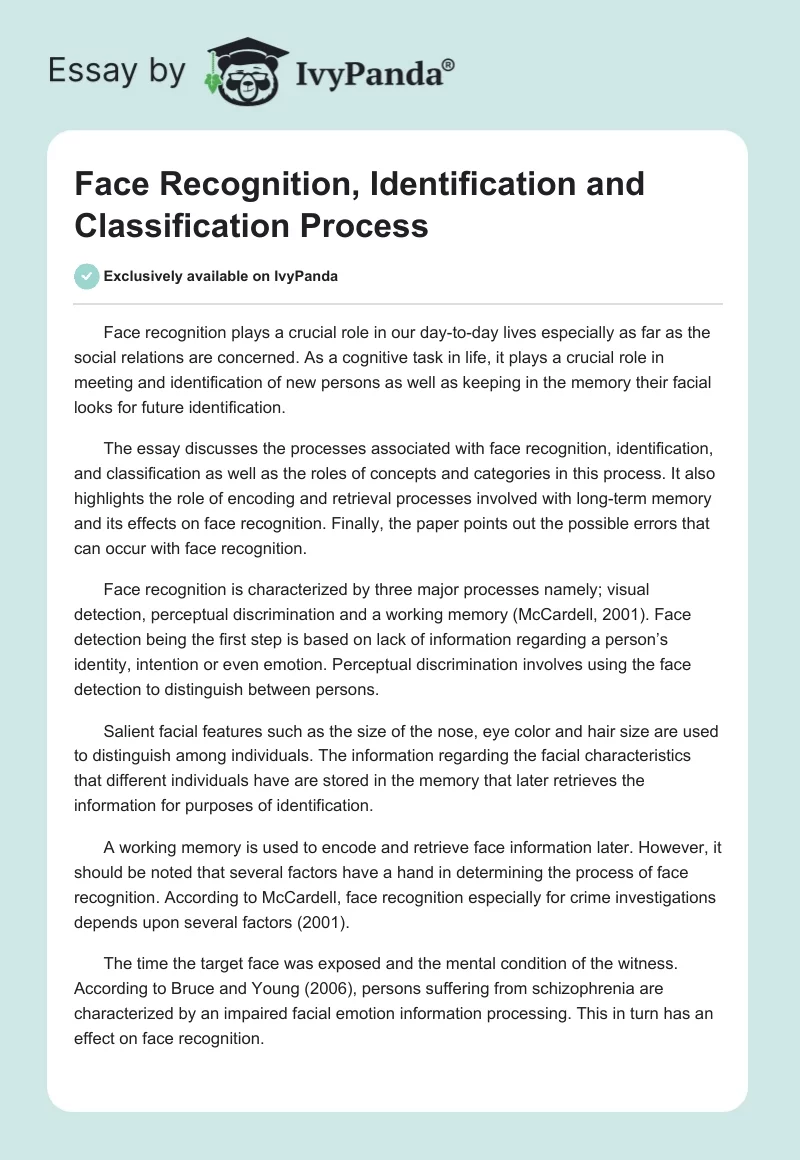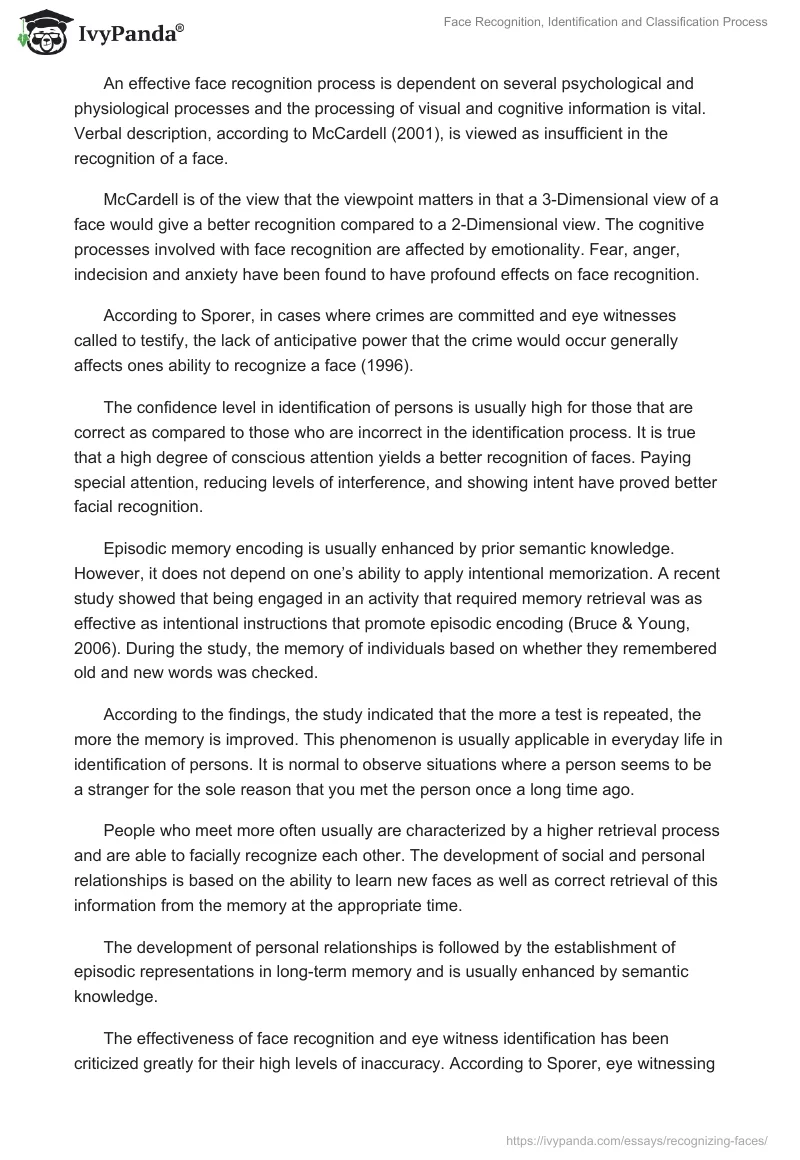Face recognition plays a crucial role in our day-to-day lives especially as far as the social relations are concerned. As a cognitive task in life, it plays a crucial role in meeting and identification of new persons as well as keeping in the memory their facial looks for future identification.
The essay discusses the processes associated with face recognition, identification, and classification as well as the roles of concepts and categories in this process. It also highlights the role of encoding and retrieval processes involved with long-term memory and its effects on face recognition. Finally, the paper points out the possible errors that can occur with face recognition.
Face recognition is characterized by three major processes namely; visual detection, perceptual discrimination and a working memory (McCardell, 2001). Face detection being the first step is based on lack of information regarding a person’s identity, intention or even emotion. Perceptual discrimination involves using the face detection to distinguish between persons.
Salient facial features such as the size of the nose, eye color and hair size are used to distinguish among individuals. The information regarding the facial characteristics that different individuals have are stored in the memory that later retrieves the information for purposes of identification.
A working memory is used to encode and retrieve face information later. However, it should be noted that several factors have a hand in determining the process of face recognition. According to McCardell, face recognition especially for crime investigations depends upon several factors (2001).
The time the target face was exposed and the mental condition of the witness. According to Bruce and Young (2006), persons suffering from schizophrenia are characterized by an impaired facial emotion information processing. This in turn has an effect on face recognition.
An effective face recognition process is dependent on several psychological and physiological processes and the processing of visual and cognitive information is vital. Verbal description, according to McCardell (2001), is viewed as insufficient in the recognition of a face.
McCardell is of the view that the viewpoint matters in that a 3-Dimensional view of a face would give a better recognition compared to a 2-Dimensional view. The cognitive processes involved with face recognition are affected by emotionality. Fear, anger, indecision and anxiety have been found to have profound effects on face recognition.
According to Sporer, in cases where crimes are committed and eye witnesses called to testify, the lack of anticipative power that the crime would occur generally affects ones ability to recognize a face (1996).
The confidence level in identification of persons is usually high for those that are correct as compared to those who are incorrect in the identification process. It is true that a high degree of conscious attention yields a better recognition of faces. Paying special attention, reducing levels of interference, and showing intent have proved better facial recognition.
Episodic memory encoding is usually enhanced by prior semantic knowledge. However, it does not depend on one’s ability to apply intentional memorization. A recent study showed that being engaged in an activity that required memory retrieval was as effective as intentional instructions that promote episodic encoding (Bruce & Young, 2006). During the study, the memory of individuals based on whether they remembered old and new words was checked.
According to the findings, the study indicated that the more a test is repeated, the more the memory is improved. This phenomenon is usually applicable in everyday life in identification of persons. It is normal to observe situations where a person seems to be a stranger for the sole reason that you met the person once a long time ago.
People who meet more often usually are characterized by a higher retrieval process and are able to facially recognize each other. The development of social and personal relationships is based on the ability to learn new faces as well as correct retrieval of this information from the memory at the appropriate time.
The development of personal relationships is followed by the establishment of episodic representations in long-term memory and is usually enhanced by semantic knowledge.
The effectiveness of face recognition and eye witness identification has been criticized greatly for their high levels of inaccuracy. According to Sporer, eye witnessing is usually a subjective method to face recognition especially when investigating crimes (1996). A recent crime investigation based on eye-witness identification resulted to the conviction of the innocent whereas the guilty went scot free.
According to McCardell (2001), various factors contribute to these anomalies among them weapon focus. A witness can place much of his/her focus on the weapon used to commit crime and as a result be unable to identify the person involved. False identification may thus ensue leading to false conviction.
The decision on whether or not a face is known is crucial in facial recognition. Self recognition, on the other hand, may be inconsistent especially when we share experiences with people who look similar in one way or the other. This may change facial recognition of our own selves. The notion that a person looks similar to you is also manifested in facial recognition.
The paper has elaborated the concept of face recognition. The facial recognition approach to identification is usually a social asset. Its effective application in crime investigations should be based on an objective approach to avoid cases of misidentification and false conviction.
References
Bruce, V. & Young, A. (2006). Understanding face recognition. British Journal of Psychology, 13, 234-245
McCardell, E. (2001). Face Recognition: Cognitive and Computational Processes.
Amsterdam/Philadelphia: John Benjamin’s Plc. Co.
Sporer, S. L. (1996). Introduction to eye-witness identification. Psychological Issues in Eye-witness Identification, 5, 3-12. New Jersey, NJ: Lawrence Erlbaum.


